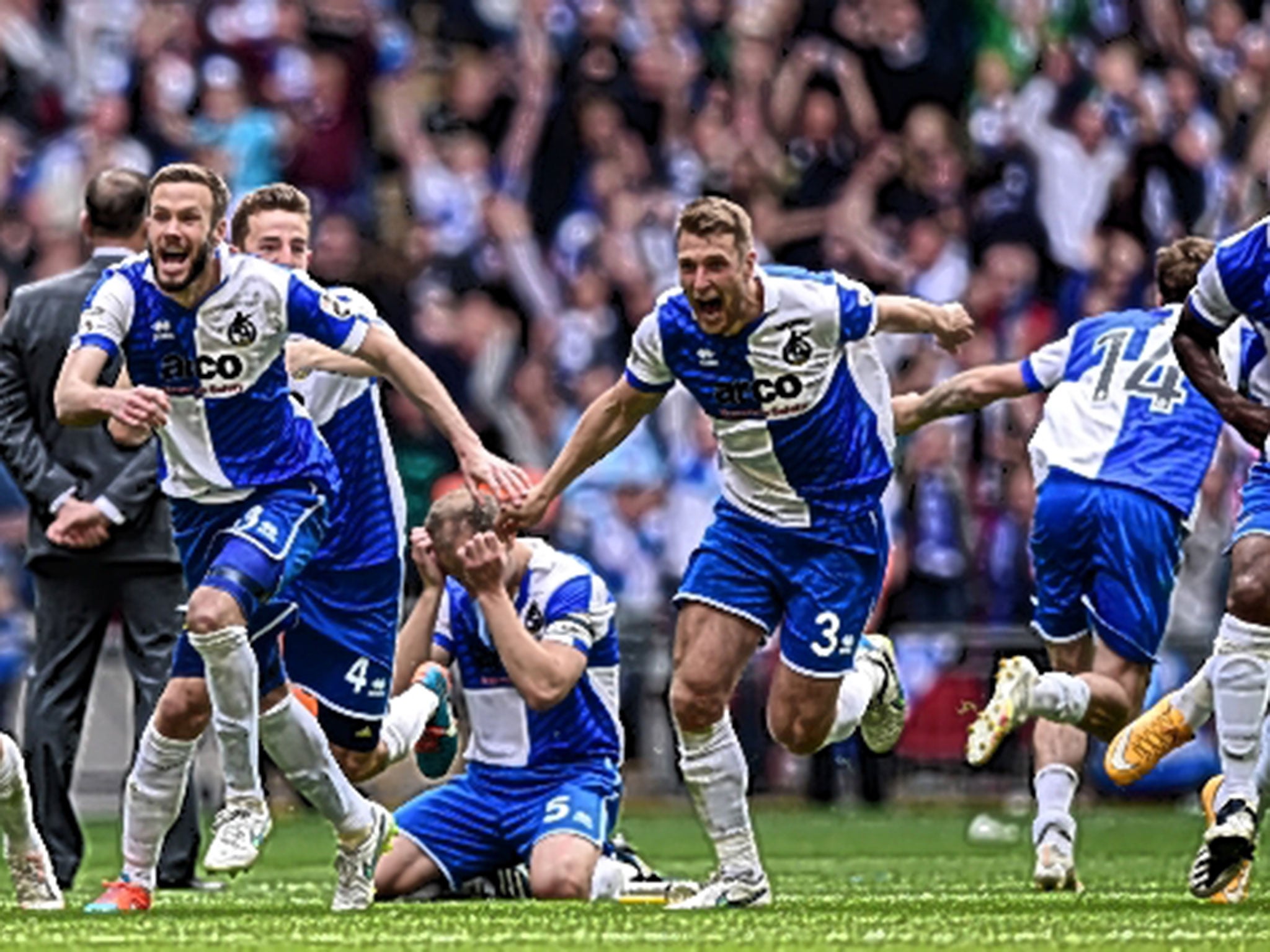Buoyant Bristol back in big time
After years in the doldrums, City and Rovers’ promotions have heightened ambitions again, writes Simon Hart

“Going up the motorway, there was a massive sea of red and white.” Paul Cheesley is not remembering the exodus of 45,000 Bristol City fans to Wembley for last season’s Johnstone’s Paint Trophy final victory but rather a different journey to north London, made four decades ago.
It was August 1976, City were playing at Arsenal in their first top-flight fixture since 1911, and the former striker remembers it well – he headed the only goal in a famous 1-0 win. “The whole city was buzzing, playing in the First Division for first time in 65 years,” he recalls. “We were a force to be reckoned with and proved it by staying up for four seasons.”
Then 22, Cheesley had to retire after picking up a knee injury in the next match – which might be said to reflect the way it has gone for the club, and football in the city generally, over the last three decades.
You would have to be nearing 50 to remember Alan Dicks’ team, which included centre-back Geoff Merrick, midfielder Gerry Gow and striker Joe Royle. Since relegation from the old First Division in 1980 they have been yo-yoing between the second and third tiers.
In the same period, neighbours Bristol Rovers have swung between the third and fourth tier before dropping into the Conference in 2014. Bristol, with its 440,000 population, is the largest city in the country not to have hosted Premier League football.
Yet a memorable 2014-15 campaign means there should be a spring in the step of both sets of supporters entering the new season. City were runaway League One winners in the spring while Rovers, in front of 30,000 of their fans, defeated Grimsby Town on penalties in the Conference play-off final to return to the Football League.
For City, in particular, the sense of progress has continued over the summer: the construction of their new South Stand is complete, the first phase in the £45m remodelling of Ashton Gate, and manager Steve Cotterill is hoping to continue building something special on the pitch.
“I said when I came in and we were bottom of League One [in December 2013] that I felt Bristol could host a Premier League club and that would be our aim,” he tells The Independent on Sunday. “There is no point in shying away from it. I am not saying that can happen all of a sudden – we will need some adjustment time.
“But it is what you have to aim for. In a year’s time our stadium will be nigh on complete with 27,000 and if we can get into the Premier League it will be magnificent because we’ll fill it every week. Swansea did it and Cardiff City did it and they are not bigger cities than Bristol.”
Cotterill, 51, has provided an impressive reaffirmation of his managerial abilities. After his dismissal by Nottingham Forest in 2012, he spent time observing French club Lille. Last season saw him acheive his fifth career promotion.
It helps, of course, to have a billionaire owner in Steve Lansdown, who also owns Bristol Rugby Club. They, too, have high hopes of reaching the Aviva Premiership, but have fallen just short after losing the play-off finals for the last two seasons.
Though Lansdown is funding Ashton Gate’s redevelopment, City are taking a careful approach in the transfer market. When they last came out of League One – losing the 2008 Championship play-off final 12 months later – they spent big but relegation followed in 2013, Lansdown having to wipe out £35m of debt. By contrast, Cotterill’s only signing since promotion has been the £2.1m French forward Jonathan Kodjia.
Asked why success has long eluded Bristol’s clubs, Cheltenham-born Cotterill cites as one factor the “corridor along the West Country that for years has been dominated by rugby”. Another hindrance, according to one observer of Bristol football, is the longstanding problem of realising development plans there.
City’s plan for a new stadium at Ashton Vale collapsed after a six-year application process. Rovers, who even relocated to Bath from 1986-96, are in a legal battle with Sainsbury’s over the supermarket’s withdrawal from a £30m deal to buy the Memorial Ground, which would have enabled the club to build a 21,700-seat stadium on the University of West of England campus. The High Court ruled in favour of Sainsbury’s in July, but Rovers were given leave to appeal on Friday.
Darrell Clarke, the Rovers manager, says: “There is huge potential, but for whatever reason both clubs have not fulfilled it as it stands. Obviously Bristol City have a well-known owner who has pumped a hell of a lot of money in and I am sure they are itching to try to get into the Premier League. For ourselves, with a tremendous fan base, we are looking to get up the pyramid again.”
Clarke, who at 37 has two promotions with Salisbury City to his name, cites the 10,000-plus crowds that watched Rovers’ final two home games last season to underline his conviction that his club should be aiming for League One. City, of course, are aiming even higher.
Cheesley, meanwhile, is optimistic about the club’s future. “They are all working together as a unit, not unlike we were,” he said. “If [Cotterill] keeps that attitude going and adds a couple more heads to strengthen the squad we can consolidate for a season or too then really push for the Premier League.”
Subscribe to Independent Premium to bookmark this article
Want to bookmark your favourite articles and stories to read or reference later? Start your Independent Premium subscription today.

Join our commenting forum
Join thought-provoking conversations, follow other Independent readers and see their replies